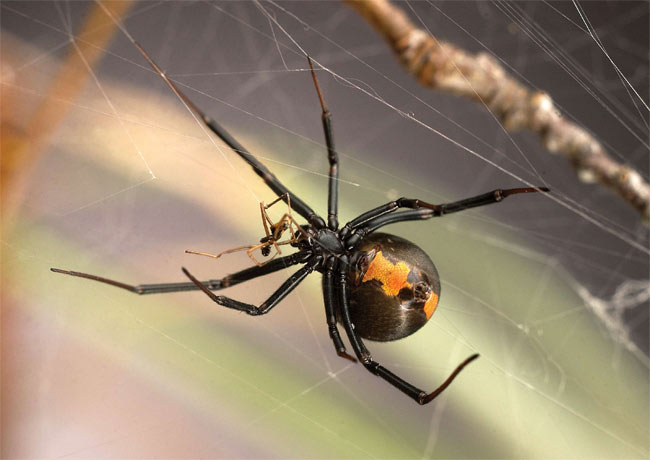Sneaky Spider Skips Long Sex Dance

In the arachnid version of trying to get some, male suitors of a female cannibalistic spider must perform a 100-minute-long dance on the gal's web lest they be eaten before copulation is complete.
Or, they can just cheat.
The finding comes from a new study that focused on the poisonous Australian redback spider (Lactrodectus hasselti), a member of the black widow family. A rival male redback can slip by the hard-working suitor and mate with the female without having to put in much courtship time, the researchers found.
Here's how the spiders get down to business:
Males, which are just 1 percent to 2 percent of a female's body weight, dance about the web of a potential mate, plucking at the threads and sending out vibrations.
Once the male redback has performed an adequate dance, the female will allow him to mount her and insert one of his two palps, or copulatory organs, into one of a pair of sperm storage organs. The male then somersaults to place its abdomen directly above his mate's fangs.
That's perfect positioning for the female to begin devouring the male's body. "After about 15 to 20 minutes of this somersault position, he'll flip back over partially digested," study researcher Jeffrey Stoltz, doctoral candidate at the University of Toronto Scarborough, told LiveScience.
Sign up for the Live Science daily newsletter now
Get the world’s most fascinating discoveries delivered straight to your inbox.
To make for a successful mating, the male must strut his stuff again on the web for a brief stint to gain access to the female's other sperm storage organ. Like some other spiders, the redback males break off part of their copulatory organs in the female to keep her from re-mating. But if one sperm sac were left unplugged, a rival could come in and father half of the female's offspring.
The team wanted to figure out how long a male of this species had to court the female to have the best chances of full paternity (filling up both of her sperm storage organs).
From a series of lab experiments, they found if a male spider courted for 100 minutes or longer, the female would very likely let him have two sex sessions. Below that threshold and the female would likely kill and eat the male after the first copulation. (Regardless, the male is giving his life, as the female will polish him off, at best, after the second mating.)
In addition to finding this threshold, the researchers observed sneaky rivals of a courting male could saunter onto the web and mate with the female with little effort. If the female has gotten her 100 minutes or so of courting from the other male, this second male can just slip by and gain access to the female.
"These intruding males could approach the females and mate with extremely little investment into courtship, after being on the web at a minimum of 15 to 20 minutes," Stoltz said.
The researchers tested various size redbacks, finding even the small guys could mate with this already primed female with little investment.
"One of the surprising outcomes from the study is that females are unable or unwilling to discriminate the sources of courtship," Stoltz said. "This has provided the opportunity for intruding males to exploit the reproductive efforts of rivals and thereby circumvent female choice."
The study is published in a recent issue of the journal Proceedings of the Royal Society B.
- Video – Spider Coupling
- Spider News, Images and Information
- Images: Creepy Spiders
Jeanna Bryner is managing editor of Scientific American. Previously she was editor in chief of Live Science and, prior to that, an editor at Scholastic's Science World magazine. Bryner has an English degree from Salisbury University, a master's degree in biogeochemistry and environmental sciences from the University of Maryland and a graduate science journalism degree from New York University. She has worked as a biologist in Florida, where she monitored wetlands and did field surveys for endangered species, including the gorgeous Florida Scrub Jay. She also received an ocean sciences journalism fellowship from the Woods Hole Oceanographic Institution. She is a firm believer that science is for everyone and that just about everything can be viewed through the lens of science.









